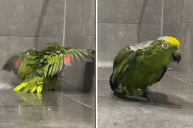It's been more than half a century since researchers last saw this lost species. Now, it's surfaced for the first time, and someone managed to snap a photo as well.
The bird species hasn't been documented in 44 years. Fortunately, that's now changed. The lost species is found. On Sept. 13, the World Wildlife Fund confirmed a photographer snapshotted a photo of a New Britain Goshawk in Papua New Guinea. Tom Vierus, a photographer from Fiji, managed to photograph the lost species. He was in the Nakanai Mountains when he managed to glimpse the species.
However, the photographer didn't realize he struck the photo equivalent of winning the lottery.
"I was on a scoping trip with WWF in Pomio [eastern New Britain], with three members of the local community guiding us through the forest, so we could better understand the presence of species," Vierus shared in a WWF release. "I photographed several bird species, including the New Britain Goshawk, but wasn't aware of the significance at the time."
Lost Species Found
While documentation is rare, the bird isn't actually on the cusp of going extinct. The International Union for Conservation of Nature's Red List of Threatened Species estimates there are 2,500-9,999 birds. It labeled the lost species as vulnerable but not endangered.
So when was the last time someone documented the bird? You'd have to go back to 1969. John Mittermeier, the director of the Search for Lost Birds at American Bird Conservancy, says the bird has "eluded photo, sound, and specimen documentation for 55 years. "

WWF-Pacific / Tom Vierus
"It was such a great surprise to hear that this photo seems to be the first-ever of this 'lost species!' It is wonderful to see how conservation photography can help in safeguarding areas by documenting the existing biodiversity and also a good reminder of how important visual storytelling is," Vierus said of his New Britain Goshawk photo.
Meanwhile, the WWF plans to do more work in New Guinea. Martha Eimba, the Pomio landscape manager of WWF-Papua New Guinea, said that the WWF has "begun a process of collaboration to understand the threats, livelihood opportunities, and social contexts" in the area.




